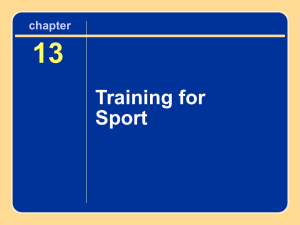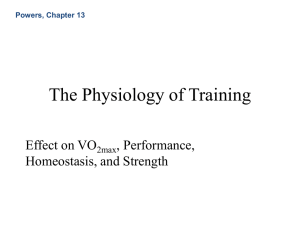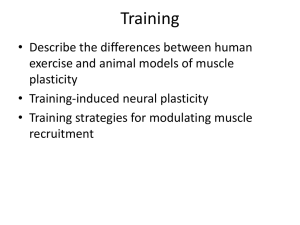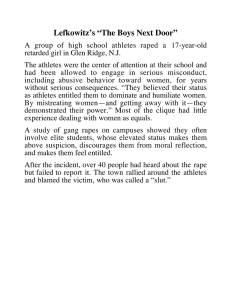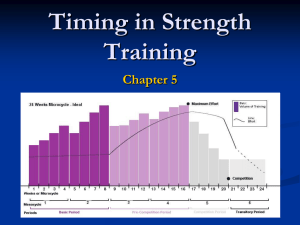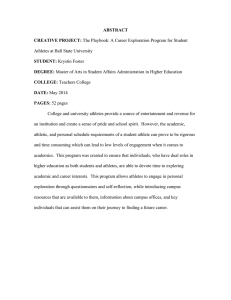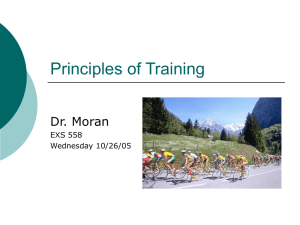THE DETRAINING EFFECTS OF COMPLETE INACTIVITY By: Sigit Nugroho, M.Or
advertisement
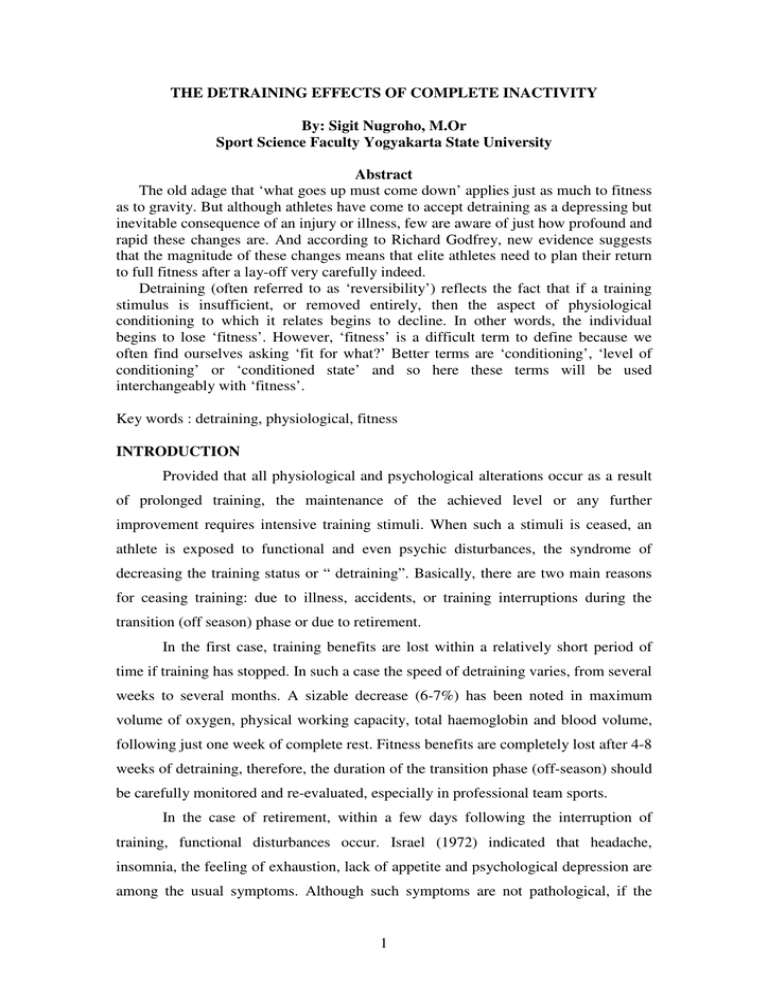
THE DETRAINING EFFECTS OF COMPLETE INACTIVITY By: Sigit Nugroho, M.Or Sport Science Faculty Yogyakarta State University Abstract The old adage that ‘what goes up must come down’ applies just as much to fitness as to gravity. But although athletes have come to accept detraining as a depressing but inevitable consequence of an injury or illness, few are aware of just how profound and rapid these changes are. And according to Richard Godfrey, new evidence suggests that the magnitude of these changes means that elite athletes need to plan their return to full fitness after a lay-off very carefully indeed. Detraining (often referred to as ‘reversibility’) reflects the fact that if a training stimulus is insufficient, or removed entirely, then the aspect of physiological conditioning to which it relates begins to decline. In other words, the individual begins to lose ‘fitness’. However, ‘fitness’ is a difficult term to define because we often find ourselves asking ‘fit for what?’ Better terms are ‘conditioning’, ‘level of conditioning’ or ‘conditioned state’ and so here these terms will be used interchangeably with ‘fitness’. Key words : detraining, physiological, fitness INTRODUCTION Provided that all physiological and psychological alterations occur as a result of prolonged training, the maintenance of the achieved level or any further improvement requires intensive training stimuli. When such a stimuli is ceased, an athlete is exposed to functional and even psychic disturbances, the syndrome of decreasing the training status or “ detraining”. Basically, there are two main reasons for ceasing training: due to illness, accidents, or training interruptions during the transition (off season) phase or due to retirement. In the first case, training benefits are lost within a relatively short period of time if training has stopped. In such a case the speed of detraining varies, from several weeks to several months. A sizable decrease (6-7%) has been noted in maximum volume of oxygen, physical working capacity, total haemoglobin and blood volume, following just one week of complete rest. Fitness benefits are completely lost after 4-8 weeks of detraining, therefore, the duration of the transition phase (off-season) should be carefully monitored and re-evaluated, especially in professional team sports. In the case of retirement, within a few days following the interruption of training, functional disturbances occur. Israel (1972) indicated that headache, insomnia, the feeling of exhaustion, lack of appetite and psychological depression are among the usual symptoms. Although such symptoms are not pathological, if the 1 cessation of training persists, they may be displayed for a long time, even years, indicating the inability of the human body to adjust to a state of inactivity. In general, the removal of a training stimulus produces a significant loss in conditioning after two to six weeks. In addition, it is simply not possible to train all aspects of physiology simultaneously, hence the concept of period. To date, the vast majority of detraining research has focused on club level athletes hardly surprising as it’s very difficult to convince elite athletes to stop training just to allow scientists to get a feel for the consequences. For the first time, however, this article will present findings from an elite athlete the author’s own research data on the detraining and retraining of an Olympic gold medallist rower. What happens to highly conditioned athletes who have dine-tuned their performance skills to am peak level but find that the commpetitive season and daily training have come to a sudden end? Most athletes in team sports go into physical hibernation at this time. Many have been working 2 to 5 hr each day to perfect their skills and improve their physical condition and welcome the opportunity to completely relax, puposely avoiding any strenuous physical activity. Athletes generally agree that suffering the pain of an injury is bad enough, but situation is ev en worse when it force them to stop training. Most fear that all they have gained through hard training will be lost during a period of inactivity. But recent studies reveal that a few daya of rest or reduced training will not impair and might even enhance performance. Yet at some point, training reduction or complete inactivity will produce a decrement in physiological function and performance. (Wilmore Costill, 1994: 309) LITERATURE REVIEW Most training benefits are lost within a relatively short period of time after training has stopped. The speed of complete detraining effect is, however, some what variable, requiring anywhere from several weeks to several months. For example, sizable decreases 6 to 7 % have been noted in max VO2, physical working capacity, total hemoglobin, and blood volume following just 1 week of complete bed rest (Friman, 1979). In addition, in rats it has been shown that onehalf of the absolute increase in cytochrome C (one of the electron transport system enzymes) caused by training will be lost in just 7 days (Booth and Holloszy, 1977). At this rate, the activity of the enzyme would be at pretraining values in about 1 month. A similar time 2 course of response for other muscle enzyme in human has also been demonstrated (Fox, Bowers and Foss, 1993: 355). Obviously, in such circumstances the best therapy is physical activity. For athletes who experience an injury or illness, the coach should cooperate with the physician in prescribing adequate, if any, physical training. Although during most illnesses physical activity is not advisable, the injured athletes may be in a position to endure limited exertion, which still may maintain a certain level of physical preparation and may lessen the detraining syndrome. during the recuperation, especially following illness. Training must be progressive with the body’s readaptation to previous stimuli as the main objective. The duration of training may be increased from 10-15 minutes to 60 minutes and later to 90 minutes, with a load of up to 50% of the load utilized prior to the illness. In such circumstances, according to Israel (1972), the heart rate may reach levels of between 140-170 beats per minute. Of special concern to each coach should be those athletes who retire from training. Throughout each athlete’s career he / see ought to learn that after retirement the cessation of training has to be reduced progressively. Detraining has to be organized over many months and even years, so that the athlete’s body may be progressively brought down to a low level of activity. As far as the content, volume and intensity of training is concerned. It may be planned according to each individual’s free time and sporting facilities. Among the first training parameters to be reduced progressively are the number of training lessons and the intensity. The number of lessons may be reduced to 3-5 sessions per week, with a progressively lower intensity. As time progresses, the volume of training, especially its duration, ought to be lessened as well. The content of physical activity should be diverse. In fact, in most cases, exercise from other sports may be considered since the athletes may be saturated by those from their own specialty, which were performed for several years. Running, swimming and cycling may be considered by most athletes, since they can be performed individually and serve to maintain an adequate level of fitness. Although the above are just general suggestions, detraining is of concern to all athletes. All athletes, following their retirement, should remain physically active for their own general physical and mental well-being (Bompa, 1994: 21). 3 A. Effects of Detraining on the Major Physiological Systems According to Richard Godfrey (2008) effects of detraining on the major physiological systems 1. Cardio-respiratory detraining Maximal oxygen uptake (VO2max) has been shown to decline by anything from 4-20% with inactivity of two weeks or more. VO2 max has two major components: maximal cardiac output (Q max – litres per minute) and the maximal rate of oxygen uptake and consumption in the working muscles. This explains why two types of training improve VO2max. High intensity intervals (heart rate greater than 90% of max) of two to four minutes are used to improve Q max and long slow distance (LSD) training is used to improve oxygen uptake and consumption in the muscles. With detraining of endurance-trained athletes blood volume is reduced by 5-12% within the first two days. This reduction in blood volume is the primary reason for the observed rapid decline in cardiovascular function. As a direct result there is a decrease in cardiac output (amount of blood pumped per minute) and stroke volume (amount of blood pumped per beat) with an attendant increase in heart rate during sub maximal exercise – consistent with the equation 2. Cardiac Output = Heart Rate x Stroke Volume The dimensions of the heart have been found to decrease in parallel with stroke volume during eight weeks of inactivity, with left ventricular posterior wall thickness decreasing progressively by 25% and left ventricular mass decreasing by almost 20% in the first three weeks. Respiratory function is also altered with inactivity. Maximal voluntary ventilation has been shown to decrease by 10-14%, while in the longer term the ventilator response to increasing carbon dioxide levels increases after two years without training. It also appears that the energy cost of breathing is increased with detraining as increasingly more blood flow is ‘stolen’ by respiratory muscles working at more than 55% of forced vital capacity. 3. Metabolic detraining Respiratory exchange ratio (RER) is calculated from the amount of oxygen consumed versus the amount of carbon dioxide produced during exercise, and gives an indication of which fuels (fat, carbohydrate and protein) predominate. After detraining has occurred, there’s a comparative increase in the amount of carbohydrate used as fuel during both maximal and sub maximal exercise, with 4 less energy derived from fat. As a consequence of hard training at or close to lactate threshold for a number of weeks, two main adaptations occur providing evidence of improved endurance: reduced sub maximal blood lactate and a higher exercise intensity before lactate threshold is reached (see box below). However, with detraining the opposite occurs, and higher blood-lactate concentrations have been measured in swimmers and in endurance-trained runners and cyclists at a lower percentage of VO2max after just a few days of inactivity. However, when compared to sedentary individuals, those previously highly trained still have a lactate threshold at a higher percentage of their VO2max, even after detraining. 4. Muscular detraining In previously active individuals, four weeks without training results in muscle capillarisation returning to pre-training baseline but it still remains above that found in sedentary individuals. Oxygen uptake in muscles has been found to decrease by 8% and this is suggested to lead to the 9% decrease in VO2max observed after 3-12 weeks without training. One effect of aerobic training on muscle is an increase in the volume of mitochondria, the organelles in cells responsible for aerobic energy production. With detraining, the volume of mitochondria is reduced. However, before that occurs, the activity of the oxidative enzymes in the mitochondria can decline by 25-45% up to 12 weeks after training cessation. With high-intensity strength and power training there is increased cellular signalling that dictates many molecular changes. These cause increases in protein synthesis of the larger fast- twitch fibres and hence, several weeks after beginning training, muscle hypertrophy accompanies the observed increases in strength and power. With detraining, however, muscle cross-sectional area decreases and there is an increase in the number of oxidative fibres (slow- twitch) versus glycolytic (fast-twitch) fibres in elite power lifters and body builders. 5. Hormonal detraining Twelve weeks of inactivity has been shown to lead to a less efficient catecholamine response, that is an increased adrenaline and noradrenaline concentration during sub maximal exercise at the same relative intensity. In plain English, the same exercise is more stressful after detraining. However, some strength-trained individuals showed some positive hormonal changes after 14 days of inactivity, with increased growth hormone and testosterone and decreased cortisol concentrations in the blood. 5 According to Wilmore and Costill (1994) in the following sections, we will exame physiological responses to detraining. We will look at specific areas of concern to the athlete: a. Muscle strength and power b. Muscular endurance c. Speed, agility and flexibility d. Cardiorespiratory endurance Detraining causes muscle atrophy, which is accompanied by losses in muscle strength and power. However, muscles require only minimal stimulation to retain these qualities during periods of reduced activity. Muscular endurance decreases after only 2 weeks of inactivity. Possible explanation for this are decreased oxidative enzyme activities, decreased muscle glycogen storage, disturbance of the acid-base balance, and decreased blood supply to the muscles. Detraining losses in speed and agility are small, but flexibility is lost quickly. To avoid injury, atheletes should engage in year-round flexibility training. With detraining, losses of cardiorespiratory endurance are much greater than losses of muscle sterngth, power, and endurance. To maintain cardiorespiratory endurance, training must be conducted at least three times per week, and training intensity should be at least 70% of the regular training intensity. B. Detraining effects on performance Detraining has a number of consequences for endurance performance. We know, for example, that swimming performance decreases when time is taken off between seasons. In soccer players, detraining is shown to decrease the time to exhaustion by 24% in five weeks. With long-term inactivity there can be a large decline or even a complete reversal of training-induced performance improvements. However, a relatively short break is generally not too bad and, providing the previous training adaptations were achieved with long-term (6-12 weeks) training, two weeks without training doesn't appear to produce a significant change in time to exhaustion. 6 Figure 1. Exercise protocol or ‘step test’ used with rowers Figure 2. An example of the submaximal portion of the lactate/work curve C. Effects of Detraining With eight weeks of complete inactivity the following changes were recorded: 1. The athlete lost 2kg in body weight; 2. Estimated percentage body fat remained the same (demonstrating a loss of muscle mass); 3. VO2max decreased by 8%; 4. Power at VO2max decreased by 20%; 5. Oxygen economy had decreased by 6%; 7 6. Power at reference blood lactates of 2 and 4mM (see figure 2) declined by 27% and 22% respectively; 7. Power at lactate threshold was 30 watts lower than it had been just before the Olympics. D. Effects of Retraining After eight and 12 weeks of retraining the rower had put on 2kg of muscle and body fat was unchanged. VO2max increased by 4% in the first eight weeks of retraining but this value increased only slightly during the next 12 weeks. In fact, after 20 weeks of retraining VO2max was still 4.4% less than the pre-Olympic value. Power at VO2max increased by 15% in the first eight weeks of retraining and had returned to pre- Olympic values when retested 12 weeks later. After eight weeks of retraining, oxygen economy was back to the levels measured just before the Olympics. Power at a blood lactate reference value of 2mM was within just 4% of pre-Olympic values after 20 weeks, whilst power at 4mM was slightly better than pre-Olympic values after 20 weeks. The decline seen in VO2max after detraining is very similar in our elite athlete when compared with sub- elite athletes. However, muscular power in our elite athlete seems to show a much larger decline (more than double). This study indicates that detraining is just as much of a problem for elite athletes as it is for the sub-elite. In fact, with respect to muscular power it may be even more of a problem. Although it’s clear that the longer it takes to become well conditioned, the longer it takes to lose it, there’s little doubt that any prolonged period of inactivity will result in physiological and, ultimately, performance decline. Moreover, little work exists about the appropriate time-course for regaining physiological conditioning after a lay-off. Clearly though, it’s a ‘long road back’ and these findings suggest that the time-course for regaining top-level condition should not be guessed at, but rather assessed through regular monitoring and testing. Because practical realities might make this difficult, careful planning and restriction of time off may be required. 8 CONCLUSION Detraining refers to the cessation of regular physical training. The effects of stoping training are quite minor compared to those that result from immobilization. In general, the greater the gains durung training, the greater the losses during detraining simply because the well-trained person has more to lose than the untrained person. If your aim is to perform well over the longer term, or if you simply wish to improve your level of conditioning (‘fitness’) over a number of years then it is probably best to have no more than two weeks of complete inactivity at any one time. A better alternative would be to have a change of some kind, perhaps by performing some cross- training, or a completely different mode of activity. The old adage ‘a change is as good as a rest’ springs to mind indeed given the detraining effects of complete inactivity, a change of activity is almost certainly better than an extended period of complete rest. REFERENCES Bompa, T.O. (1994). Theory and Methodology of Training, The Key to Athletic Performance Third edition, Toronto, Ontorio Canada: Kendall/ Hunt Publishing Company. Booth, F. W., and J.O. Holloszy. (1977). Cytochrome C Turnover In rat Skeletal Muscles. J Biol Chem. Fox, Bowers and Foss (1993). The Physiological Basis for Exercise and Sport, fifth edition. USA: Brown & Benchmark Publishers. Friman, G. (1979). Effect of clinical bed rest for seven days on physical performance. Acta med scand. Israel, S. (1972) The Acute Syndrome of Detraining. Berlin, GDR National Olympic Committee Richard Godfrey ( 2008). Detraining Why a Change Really is Better than a Rest, Brunei University and British Olympic Association. Wilmore Costill (1994) Physiology of Sport and Exercise. USA: Human Kinetics Champaign . 9

